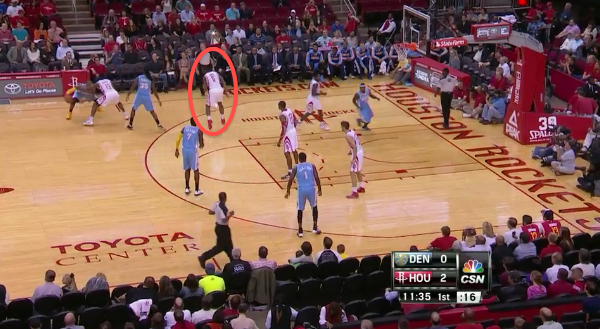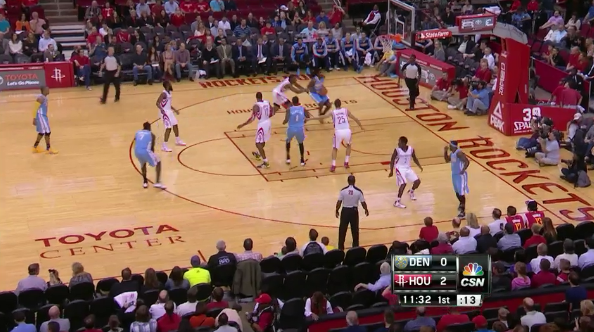Terrence Jones is an athletic mutant. That’s the most complimentary description that springs to mind whenever he’s racing around a basketball court on my television. Jones makes the difficult look effortless, but turns simple situations into a sticky Rubix cube. Two weeks ago he wasn’t in Houston’s rotation. Two nights ago he scored 11 points and grabbed five rebounds in the first quarter of a go-away thrashing against the Boston Celtics.
What we don’t know about Jones is precisely why he’s so exciting. Only 21 years old, his play in sparse minutes this season has been instinctive, energetic, and—dare I recall Bradley Cooper’s sleeper hit from 2011—limitless.
As a shot-blocker he looks like a mini-Dwight Howard, and his full on desire to take the ball coast to coast after ripping a board off the glass rekindles thoughts of a young Josh Smith. When Houston played Denver earlier this week, Jones was matched up with Kenneth Faried, a bouncy ball of exuberance. “Can Jones be Houston’s Kenneth Faried, or would that limit his potential?” was something I jotted in my notebook after watching him snag a rebound over three Denver forwards.
All these comparisons are obviously speculation (or hearsay, to some), but now that Kevin McHale has unofficially given up on an Omer Asik-Howard pairing—and until we discover the returns on whatever golden goose Morey lands for Asik—Jones is Houston’s starting power forward in the here and now. Here are three questions that should help us get to know him a little better.
How’s his overall defense?
Let’s start by listing a few opponents Jones has already spent significant time defending: Rudy Gay, Carmelo Anthony, Thaddeus Young, and Dirk Nowitzki. The good news? Jones isn’t dead. In fact, he looked under control for moments against all those guys, staying tight and preventing blow bys of the most embarrassing variety.
As a help defender Jones has the potential to be destructive. He doesn’t “roam” around the paint so much as he ricochets from point to point; his size (6’9” with a 7’2” wingspan) and quickness creates the type of plays at the rim Serge Ibaka makes on a regular basis.
Of course, a couple weeks into the rotation, Jones is definitely not Ibaka. He struggles defending the pick-and-roll and is a bit too eager out on the perimeter. At this point, basic help on the back line is more instinctual than routine, but that’s to be expected for someone who still has a ton to learn.

Circled above is Jones, about to defend a pick-and-roll with Faried as the screener.

The ball is passed to the top of the key in a nifty design sending Faried back door, and Jones falls for it, hook, line, and sinker. His head and body are still worried about the ball, when they should be worried about his man, who’s begun a dead sprint towards open space around the basket.

And there you have it. Faried scores on a bunny. This is a case of Jones relying too much on his quickness, when what he should’ve done once he saw the ball-handler go towards the middle is sag towards the elbow. Instead he came up even higher to meet Faried, who isn’t a shooting threat unless the shot comes at the rim.
In the clip below, Jones and Patrick Beverley are defending a pick-and-roll against Avery Bradley and Brandon Bass. Jones sags to the free-throw line and plays the sequence perfectly…until he doesn’t. For an unknown reason, in the middle of the play, Jones decides to shift back onto his man, the rolling Bass.
Chandler Parsons has correctly slid over to pick Bass up, and it’s Jones’ responsibility to keep Bradley from getting to the basket. Instead, an open floater is lofted. Thankfully Howard was there, ready and waiting to swallow the ball.
I’m not sure why he decides to rotate off the ball. Maybe he thought Beverley was in position to recover? Or James Harden’s decision to crash down would have an effect on Bradley’s drive? Maybe the explanation is as simple as he was duped by a decent hesitation dribble?
Regardless, Jones can’t play starter’s minutes (he’s averaging 32.4 over his Houston’s last five games, more than Jeremy Lin and Patrick Beverley) and make mistakes like that one. He’s super fast for his size, but all that’s useless if he doesn’t know how to read the offense. Jones is getting better, though, and there’s no reason to think plays like the two shown above will become a thing of the past sooner than later.
What’s his offensive role?
When Terrence Jones plays, Houston’s offense hums. He’s spent 210 minutes on the court so far this season, and in that time the Rockets have averaged a totally insane 117.3 points per 100 possessions. Also: the Patrick Beverley-James Harden-Chandler Parsons-Jones-Howard starting lineup has played 70 minutes together, and is outscoring opponents by 22.0 points per 100 possessions.
These are, of course, small sample sizes. But they’re still pretty freaking wonderful. Since replacing Asik in the starting lineup, Jones has been a delight, hitting open space with timely off ball cuts, attacking the paint with aerial assaults on the offensive glass, and making the most of opportunities from the outside when opponents leave him alone to guard Howard, Harden, Parsons, or Jeremy Lin.
Last night against the Mavericks he had 18 points on 61.5% shooting from the floor. He finished with 24 and 9 against Boston, and 14 and 12 against the Nuggets. Over his last five games he’s averaging 14.4 points and 8.4 rebounds on 56.6% shooting. He’s at 50% on three-pointers (that will obviously drop) and is attempting as many shots from the floor as Howard (who gets waaaaaaay more touches that result in trips to the free-throw line, but still).
Where Jones has been most impressive is off the dribble. Here are two plays against Denver where he gets to the basket on his own, with no assistance. Scary stuff for a defense that already has a few dozen other things to worry about.
I don’t even know what’s going on here, or how Jones slithers from the three-point line to the rim. A sequence like this will probably never happen again in his career, but that doesn’t make it any less awesome.
A bit more conventional, here’s Jones making a smart offensive play. He pump fakes, blows past his man on a drive to the rim, and draws a foul. There were 17 seconds on the shot clock when Jones caught the pass, but he still looked to attack. This aggression is a very, very good sign.
If he’s Houston’s starting power forward in May, will that be good or bad?
This is the big question, and one that’ll ultimately be determined by the pending Omer Asik trade. My personal opinion is that it wouldn’t be the worst thing in the world. It’d mean Jones is playing way above his head, because Morey wants to win now, and any deal involving Asik is most likely to bring back immediate help along with a long-term investment.
If Jones is still starting, there’s a good chance Morey had the flexibility to strike a deal solely focused on future returns (draft picks, undeveloped players on rookie contracts—think Thomas Robinson, but hopefully better—etc.). But if that’s the case, would it be enough for Houston to win the title? Again, super tough to speculate, but all that’s a million miles down the road and utterly useless in the present. What the Rockets have today is more than what they thought they had two weeks ago. That means more flexibility, both on the trade market (don’t be SHOCKED if Jones is dealt while he’s playing so well) and the basketball court.
Michael Pina is a writer, with bylines at Red94, CelticsHub, The Classical, Bleacher Report, Sports On Earth, and Boston Magazine. Follow him here.

Leave a Reply